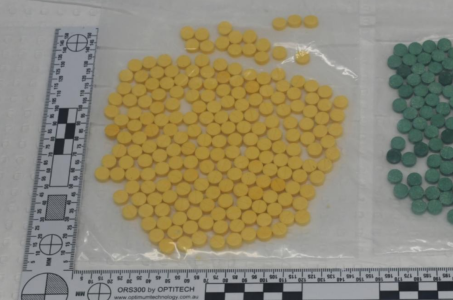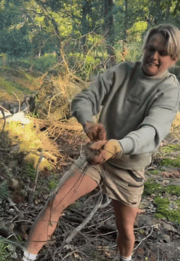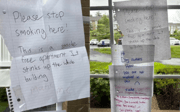‘Zombie drug’ creeps into Australia—what over-60s should know about the growing threat
By
Gian T
- Replies 0
Suppose you’ve been following the news from the United States.
In that case, you may have seen disturbing images of people in major cities like Philadelphia and San Francisco slumped over or staggering in a daze—victims of a new wave of super-strength synthetic opioids.
Now, Australian authorities are warning that these so-called ‘zombie drugs’ are making their way onto our shores, and the risks are real and growing.
The drug in question is a group of synthetic opioids known as nitazenes.
Originally developed in the 1950s for pain relief, nitazenes were never approved for medical use due to their extreme potency and risk of overdose.
However, they have recently re-emerged on the illicit drug market, often disguised as legitimate prescription medications like oxycodone, or mixed into other drugs such as heroin, cocaine, and ketamine.
Nitazenes are so powerful that even a tiny amount can be fatal.
Some variants are many times stronger than fentanyl, the opioid that has already caused a crisis in North America.
According to the Australian Federal Police (AFP), nitazenes are being smuggled into the country primarily through international mail, hidden in counterfeit pills, powders, nasal sprays, and even vape liquids.
Since January 2024, Australian Border Force officers have intercepted eight shipments of nitazenes, mostly from Canada, the UK, and Hong Kong.
So far, there’s no evidence that these drugs are being manufactured locally, but authorities are on high alert.
Recent detections have occurred in New South Wales, Queensland, Victoria, and the ACT, raising concerns that the problem could spread further.
The main danger with nitazenes is their unpredictability and potency.
Users may unknowingly take fake prescription pills or substances mixed with other drugs, leaving them unaware of what they're actually consuming or the dosage.
Even a single dose can lead to severe effects such as loss of consciousness, slow or erratic pulse, respiratory depression (slowed or stopped breathing), bluish-purple skin due to oxygen deprivation, and, in some cases, death.
There is no ‘safe’ dose of nitazenes, and even handling the drug can be risky for first responders and healthcare workers.
The AFP and Australian Border Force are working closely with international partners to intercept shipments and prosecute those responsible for importing and distributing these drugs.
They have issued strong warnings to criminal syndicates, promising to pursue offenders to the full extent of the law.
Health authorities are also urging the public to be vigilant.
NSW Ambulance and other agencies have reported an increase in overdoses linked to nitazenes, sometimes in people who thought they were taking something else entirely.
To stay safe, only take medications prescribed by your doctor and dispensed by a registered pharmacist, and never accept pills or powders from unverified sources, even if they appear to be familiar prescription drugs.
Be especially cautious with medications purchased online or from overseas, as counterfeit pills can closely resemble real ones.
If you or someone you know shows signs of an overdose—such as unconsciousness, slow breathing, or blue lips or skin—call Triple Zero (000) immediately.
Paramedics carry naloxone, which can reverse opioid overdoses, though it may not always be fully effective against nitazenes.
If you care for someone with a history of opioid use, consider keeping naloxone on hand, as it is available from pharmacies in most states without a prescription.
While the media often focuses on younger people, older Australians are not immune to the risks.
Many over-60s take prescription painkillers for chronic conditions, and may be targeted by counterfeiters or inadvertently exposed to contaminated medications.
There’s also the risk of grandchildren or other family members coming into contact with these dangerous substances.
It’s a good idea to have open conversations with your loved ones about the dangers of counterfeit drugs and the importance of only using medications from trusted sources.
If you have unused prescription opioids at home, consider returning them to your pharmacy for safe disposal.
The arrival of nitazenes in Australia is a serious public health threat, but with awareness and caution, we can protect ourselves and our families.
Remember: if in doubt, throw it out—and always consult your doctor or pharmacist before taking any new medication.
Credit: YouTube

Have you ever encountered suspicious medications or had concerns about prescription drugs? What steps do you take to keep your household safe? Share your experiences and tips in the comments below—your advice could help others in our community stay safe!
In that case, you may have seen disturbing images of people in major cities like Philadelphia and San Francisco slumped over or staggering in a daze—victims of a new wave of super-strength synthetic opioids.
Now, Australian authorities are warning that these so-called ‘zombie drugs’ are making their way onto our shores, and the risks are real and growing.
The drug in question is a group of synthetic opioids known as nitazenes.
Originally developed in the 1950s for pain relief, nitazenes were never approved for medical use due to their extreme potency and risk of overdose.
However, they have recently re-emerged on the illicit drug market, often disguised as legitimate prescription medications like oxycodone, or mixed into other drugs such as heroin, cocaine, and ketamine.
Nitazenes are so powerful that even a tiny amount can be fatal.
Some variants are many times stronger than fentanyl, the opioid that has already caused a crisis in North America.
According to the Australian Federal Police (AFP), nitazenes are being smuggled into the country primarily through international mail, hidden in counterfeit pills, powders, nasal sprays, and even vape liquids.
Since January 2024, Australian Border Force officers have intercepted eight shipments of nitazenes, mostly from Canada, the UK, and Hong Kong.
So far, there’s no evidence that these drugs are being manufactured locally, but authorities are on high alert.
Recent detections have occurred in New South Wales, Queensland, Victoria, and the ACT, raising concerns that the problem could spread further.
The main danger with nitazenes is their unpredictability and potency.
Users may unknowingly take fake prescription pills or substances mixed with other drugs, leaving them unaware of what they're actually consuming or the dosage.
Even a single dose can lead to severe effects such as loss of consciousness, slow or erratic pulse, respiratory depression (slowed or stopped breathing), bluish-purple skin due to oxygen deprivation, and, in some cases, death.
There is no ‘safe’ dose of nitazenes, and even handling the drug can be risky for first responders and healthcare workers.
The AFP and Australian Border Force are working closely with international partners to intercept shipments and prosecute those responsible for importing and distributing these drugs.
They have issued strong warnings to criminal syndicates, promising to pursue offenders to the full extent of the law.
Health authorities are also urging the public to be vigilant.
NSW Ambulance and other agencies have reported an increase in overdoses linked to nitazenes, sometimes in people who thought they were taking something else entirely.
To stay safe, only take medications prescribed by your doctor and dispensed by a registered pharmacist, and never accept pills or powders from unverified sources, even if they appear to be familiar prescription drugs.
If you or someone you know shows signs of an overdose—such as unconsciousness, slow breathing, or blue lips or skin—call Triple Zero (000) immediately.
Paramedics carry naloxone, which can reverse opioid overdoses, though it may not always be fully effective against nitazenes.
If you care for someone with a history of opioid use, consider keeping naloxone on hand, as it is available from pharmacies in most states without a prescription.
While the media often focuses on younger people, older Australians are not immune to the risks.
Many over-60s take prescription painkillers for chronic conditions, and may be targeted by counterfeiters or inadvertently exposed to contaminated medications.
It’s a good idea to have open conversations with your loved ones about the dangers of counterfeit drugs and the importance of only using medications from trusted sources.
If you have unused prescription opioids at home, consider returning them to your pharmacy for safe disposal.
The arrival of nitazenes in Australia is a serious public health threat, but with awareness and caution, we can protect ourselves and our families.
Remember: if in doubt, throw it out—and always consult your doctor or pharmacist before taking any new medication.
Credit: YouTube
Key Takeaways
- The Australian Federal Police (AFP) have issued an urgent warning about super-strength synthetic opioids called nitazenes, which are being smuggled into Australia disguised as fake prescription medicines.
- Nitazenes, which have caused major health crises in some US cities, have recently been detected in counterfeit pills, powders, nasal sprays and vape liquids across several Australian states and territories.
- Health authorities warn that nitazenes have unpredictable and potentially deadly health effects, including unconsciousness and respiratory failure, and that even frontline workers may be at risk through accidental exposure.
- The AFP and health officials urge Australians to only use medications prescribed and dispensed by registered practitioners, and warn that illegal importers and distributors of nitazenes will be prosecuted to the full extent of the law.
Last edited by a moderator:








